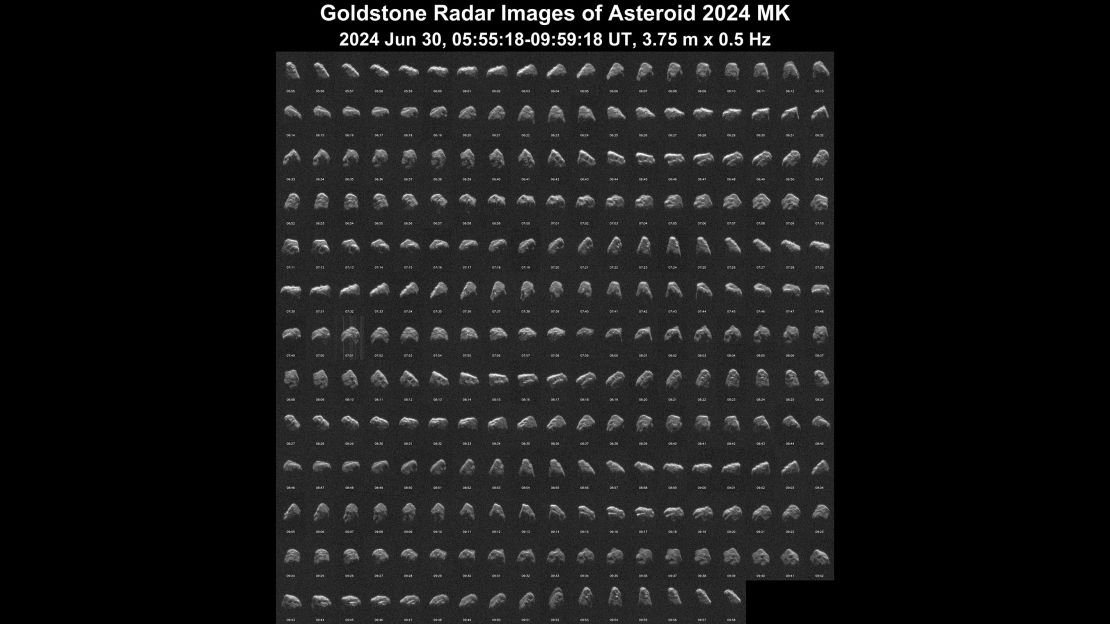Sign up for CNN’s Wonder Theory science newsletter.?Explore the universe with news on fascinating discoveries, scientific advancements and more.
When NASA scientists recently tracked the orbits of two space rocks as they made close approaches of Earth, they discovered a surprise: One of the asteroids has a little moon.
Astronomers regularly track the trajectories of asteroids to ensure that none of them are on a potential collision course with our planet.
While neither of the recent asteroids whizzed by at a concerning distance, the space rocks can yield valuable information that NASA uses to prepare for any potential future collision scenarios.
Asteroids, which are remnants left over from the formation of the solar system, are also of interest because capturing details about their size, orbit and composition can reveal insights about our corner of the cosmos.
Astronomers at NASA’s Jet Propulsion Laboratory, located in Pasadena, California, used something called planetary radar through the Deep Space Network to track and take images of the asteroids.
The Deep Space Network is a system of radio antennae on Earth that helps the agency communicate with spacecraft exploring our solar system and releases radio waves to act as radar across space.
Spotting a tiny moon
The first space rock, asteroid 2011 UL21, passed by Earth on June 27 at a distance of 4.1 million miles (6.6 million kilometers), or 17 times the distance between Earth and the moon. Researchers first discovered the asteroid in 2011 using the Catalina Sky Survey in Tucson, Arizona. But since the space rock was first spotted, its June flyby of Earth has been the closest it has swung by our planet that radar has imaged.
Astronomers transmitted radio waves from the Goldstone Solar System Radar’s 230-foot-wide (70-meter-wide) satellite dish, near Barstow, California, to the space rock. The waves reflected off the asteroid and traveled back to the network satellite dish’s antenna.
Researchers designated the nearly mile-wide (1.5-kilometer-wide) asteroid as potentially hazardous, which means it has a chance of impacting Earth in the future. But astronomers don’t think it will pose a threat to our planet for the foreseeable future after calculating its future orbits and determining it won’t come too close to Earth.
The radar images showed the asteroid is roughly spherical and is one of a pair, called a binary system. The space rock has a small moonlet orbiting it from a distance of 1.9 miles (3 kilometers).

“It is thought that about two-thirds of asteroids of this size are binary systems, and their discovery is particularly important because we can use measurements of their relative positions to estimate their mutual orbits, masses, and densities, which provide key information about how they may have formed,” said Lance Benner, principal scientist at JPL who led the observations, in a statement.
NASA missions, including the Lucy spacecraft that will explore a mysterious space rock population called the Trojans later this decade, have helped reveal just how many moonlets exist around asteroids in our solar system.
And the DART mission intentionally slammed into a moonlet called Dimorphos, which orbits a larger asteroid called Didymos, to alter the motion of a celestial body in space for the first time as a way to test asteroid deflection technology in 2022.
A space rock surprise
Sometimes, astronomers don’t know an asteroid is on an orbit that carries it close to Earth until just before it makes a near approach. That uncertainty is part of why NASA is ramping up efforts to better understand the population of asteroids that come closest to our world.
The researchers discovered asteroid 2024 MK just 13 days before it flew by Earth, zipping past at a distance of only 184,000 miles (295,000 kilometers) from our planet — just over three-quarters of the distance between Earth and the moon — on June 29.

The Asteroid Terrestrial-impact Last Alert System, or ATLAS, at Sutherland Observing Station in South Africa first spotted the space rock on June 16. While also considered potentially hazardous, the asteroid doesn’t appear to be on a concerning trajectory in relation to Earth anytime soon.
Astronomers sent radio waves to the space rock and captured a detailed image of asteroid 2024 MK. Thirty-foot-wide (10-meter-wide) boulders, as well as concave spots and ridges, litter its surface. The asteroid measures 500 feet (150 meters) wide and appears angular and elongated while also having some prominent flat and rounded areas.
As the space rock passed by our planet and encountered Earth’s gravity, its orbit changed. Now, the asteroid’s 3.3-year trip around the sun has been shortened by about 24 days.
Objects the size of asteroid 2024 MK only come near the Earth every couple of decades, so astronomers collected as much data as they could.
“This was an extraordinary opportunity to investigate the physical properties and obtain detailed images of a near-Earth asteroid,” Benner said.



